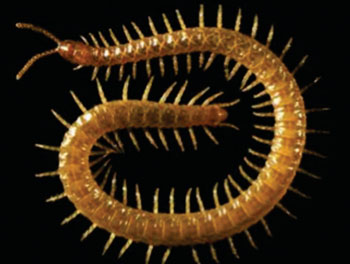Sequencing of Centipede Genome Yields Evolutionary Clues
By LabMedica International staff writers
Posted on 16 Dec 2014
In a collaborative effort involving more than 100 investigators from 50 institutions, genomic researchers have succeeded in sequencing the genome of the centipede Strigamia maritima.Posted on 16 Dec 2014
A paper published in the November 25, 2014, online edition of the journal PLoS Biology reported the first genome sequence from a species belonging to a lineage that had previously received very little attention - the myriapods. Myriapods were among the first arthropods to invade the land over 400 million years ago, and survive today as the herbivorous millipedes and venomous centipedes (the group that includes Strigamia maritima).

Image: Strigamia maritima, the centipede species genetically sequenced in the study (Photo courtesy of Dr. Carlo Brena, University of Cambridge, United Kingdom).
The compact Strigamia maritima genome was found to have undergone less gene loss and shuffling than previously sequenced arthropods and retains more characteristics of the presumed arthropod ancestor than other sequenced insect genomes. The genome provides access to many aspects of myriapod biology that have not been studied before, suggesting, for example, that they have diversified receptors for smell that are quite different from those used by insects. In addition, it shows specific consequences of the largely subterranean life of this particular species, which seems to have lost the genes for all known light-sensing molecules, even though it still avoids light.
First author Dr. Ariel Chipman, senior lecturer in ecology, evolution, and behavior at the Hebrew University of Jerusalem (Israel), said, “The use of different evolutionary solutions to similar problems shows that myriapods and insects adapted to dry land independently of each other. For example, comparing the centipede and insect genomes shows that they independently evolved different solutions to the same problem shared by all land-dwelling creatures—that of living in dry air. If we have a better understanding of the biological world around us, how it operates, and how it came to be as it is, we will ultimately have a better understanding of ourselves.”
Related Links:
Hebrew University of Jerusalem













